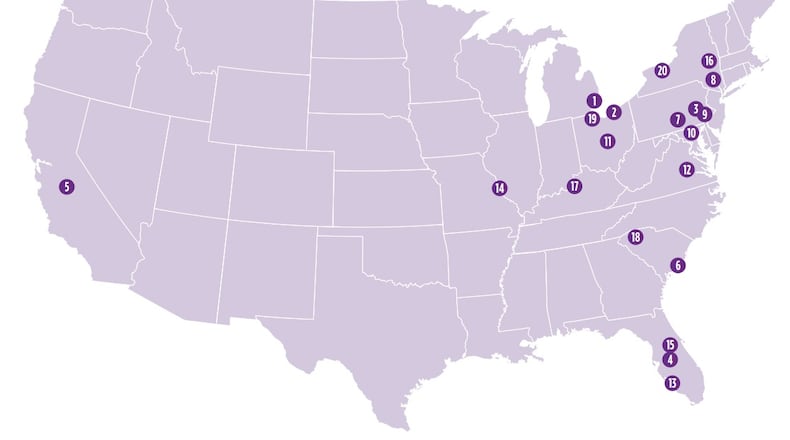Last year, Dayton was ranked the eighth most challenging city to live with asthma, but the AAFA’s new report Wednesday moved the city all the way down to 24th worst out of 100 U.S. cities. That comes on the heels of Dayton ranking 13th most challenging earlier this year for those with spring or fall allergies, better than the No. 7 national ranking the city had in that study in 2018.
While the asthma report did not specifically state why Dayton improved its standing, the city went from “average” to “better than average” under the death rate category. The city also dropped from third place to fourth place in the number of asthma-related emergency room visits.
AAFA’s 2022 Asthma Capitals Report ranks the 100 largest cities in the U.S. by how challenging they are to live in when you have asthma. The report ranks cities by the prevalence of asthma, emergency department visits due to asthma attacks, and asthma mortality.
The majority of the cities ranked in the 2022 Asthma Capitals Report are in the east or Great Lakes. Detroit is No. 1 and Cleveland No. 2, with Columbus, Toledo and Louisville also in the top 20.
Allergies play a role for asthma sufferers
“We’re in the sinus valley,” said Dr. Joseph Allen, regional medical director at Premier Health. Changing weather temperatures, patterns, and seasons also play a role in making Dayton a challenging area for asthma and allergies, as well as mold.
“If you know what your allergen triggers are, avoid the triggers,” Allen said.
Allen said a number of factors could worsen asthma and allergy symptoms for those who suffer from them, including Dayton’s history as an industrial area, air pollution from being one of the most heavily traveled areas in the region with the intersection of Interstates 70 and 75, as well as environmental factors.
Allergies also can come hand in hand with asthma struggles.
“Asthma in general is often times triggered by outdoor allergens,” said Dr. Nicholas R. Bellanco, Kettering Health family physician.
In AAFA’s 2022 Allergy Capitals rankings, Dayton ranked 13th toughest out of 100 metropolitan areas. The report takes into account the spring and fall pollen scores, over-the-counter medicine use, and availability of board certified allergists and immunologists.
Indoor allergies, like dust mites and mold, along with infections and outdoor allergies can trigger asthma, Bellanco said.
“It’s pretty difficult to avoid some of these outdoor allergens,” Bellanco said. He recommended keeping windows to homes and cars closed, changing air filters in air conditioners and vehicles, and staying indoors when possible. He also recommended showering before bed to remove allergens from hair and skin to prevent contaminating the bed, as well as using over-the-counter nasal sprays or neti pots to wash allergens from the nose after an outdoor activity, like mowing the grass.
COVID-19 also presents a challenge for doctors, as newer COVID variants share similar symptoms to allergies, such as congestion. A fever and muscle aches usually indicates COVID or a cold, whereas an itchy nose or eyes leans more toward allergies.
“Now, COVID isn’t as severe and it’s mimicking allergies. It does present sort of a challenge in the outpatient office,” Bellanco said.
According to the 2022 Asthma Capitals Report, Dayton is average when it comes to asthma prevalence, is better than average when it comes to the crude death rate for asthma, and worse than average in regard to emergency department visits for asthma. When the report takes just emergency department visits into account, Dayton ranks fourth, with Columbus in third place.
Poverty impacts challenges with asthma
Social and structural determinants of health taken into account in the Asthma Capitals report include poverty, air pollution, pollen, indoor air quality, and smoking, as well as if there is a lack of access to medication, specialists, and/or health insurance.
In taking poverty into consideration, individuals with low income and low wealth are more likely to have a poor quality of housing, live near highways and/or other highly polluted areas, and struggle to pay for treatment. According to the Centers for Disease Control, people living below 100% of the poverty level are more likely to have asthma than those living above the poverty level.
From 2008 to 2013, the annual economic cost of asthma was estimated at approximately $82 billion, according to AAFA’s 2022 Asthma Capitals Report. The cost for asthma-related medical costs for the average person in the U.S. is approximately $3,266 annually.
Make sure you are using the correct medication
Use of quick-relief medicine is also high among Ohioans and local residents. According to AAFA, Dayton ranks fifth out of metropolitan areas where quick-relief medicine use is highest. Toledo is fourth, with Cleveland and Columbus in eighth and ninth places, respectively.
If someone is using quick-relief medicine too often, doctors recommend they reach out to their health care provider to see if there is a better way to manage to asthma and allergy symptoms. According to the Journal of Allergy and Clinical Immunology, more than half of people who use inhalers do not know how to do each step correctly.
“You shouldn’t be using that (Albuterol) more than once a week,” Allen said. He said some patients may need to be on a controlling medication if they are using quick-relief medication too often. Asthma and allergy sufferers may need to take medication to help maintain allergy symptoms, too, in order to prevent triggering asthma.
“Make sure you’re treating your allergies if you need to,” Allen said.
To find the full report, visit www.aafa.org.
About the Author


